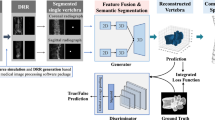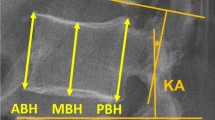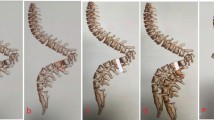Abstract
Study design:
By analyzing a large number of surgical patients, we identified the roles of wedge-shaped changes in related surgeries.
Objectives:
To illustrate the relevance of vertebral wedge-shaped changes in X-ray imaging at supine and standing positions in patients with percutaneous kyphoplasty as well as the postoperative effect.
Setting:
All patient data were collected from a hospital in China.
Methods:
Between June 2006 and May 2010, 77 surgical patients (9 men and 68 women) with wedge-shaped compression fractures were retrospectively analyzed. Patients were divided into group A (ΔWR⩾2.5%) and group B (ΔWR<2.5%) according to the dynamic changes in the percentage of vertebral body wedge-shaped variable ratio (WR) at supine and standing positions. The intensity of back pain in different positions pre- and postoperatively was evaluated with a visual analog pain scale (VAS).
Results:
The WRs in both standing and supine positions were significantly reduced by kyphoplasty in both groups A and B. In agreement with the improvement in WRs, the VAS was significantly decreased in three positions for patients in group A and in turning over and standing position for patients in group B. With respect to ΔWR changes, group B revealed significantly lower values compared with group A preoperatively (P<0.001), but there was no significant difference between groups A and B postoperatively and at 1-month follow-up (P=0.179 and P=0.558, respectively).
Conclusions:
Improvement in symptoms after kyphoplasty is better in patients with wedge-shaped changes in supine and standing positions, and the efficacy of height restoration of the spine would be better in unstable vertebrae by balloon dilatation.
Similar content being viewed by others
Log in or create a free account to read this content
Gain free access to this article, as well as selected content from this journal and more on nature.com
or
References
Reginster JY, Burlet N . Osteoporosis: A still increasing prevalence. Bone 2006; 38: S4–S9.
Riggs BL, Melton LJ 3rd . The worldwide problem of osteoporosis: insights afforded by epidemiology. Bone 1995; 17: 505S–511S.
Felsenberg D, Silman AJ, Lunt M, Armbrecht G, Ismail AA, Finn JD et al. Incidence of vertebral fracture in Europe: results from the European prospective osteoporosis study (epos). J Bone Miner Res 2002; 17: 716–724.
Rao RD, Singrakhia MD . Painful osteoporotic vertebral fracture. Pathogenesis, evaluation, and roles of vertebroplasty and kyphoplasty in its management. J Bone Joint Surg Am 2003; 85-A: 2010–2022.
Francis RM, Baillie SP, Chuck AJ, Crook PR, Dunn N, Fordham JN et al. Acute and long-term management of patients with vertebral fractures. QJM 2004; 97: 63–74.
Yamato M, Nishimura G, Kuramochi E, Saiki N, Fujioka M . Mr appearance at different ages of osteoporotic compression fractures of the vertebrae. Radiat Med 1998; 16: 329–334.
Gu XH, Yang HL, Tang TS . Balloon kyphoplasty for aged multiple osteoporotic spinal fractures. Chinese J Bone Joint Injury 2005; 20: 151–153.
Dai LY . Mri in diagnosis of osteoporotic vertral fractures: Avascular necrosis of the vertebral body. J Clin Orthipaedics 2000; 3: 9–10.
Mehta JS, Reed MR, McVie JL, Sanderson PL . Weight-bearing radiographs in thoracolumbar fractures: Do they influence management? Spine 2004; 29: 564–567.
McKiernan F, Faciszewski T . Intravertebral clefts in osteoporotic vertebral compression fractures. Arthritis Rheum 2003; 48: 1414–1419.
Toyone T, Tanaka T, Wada Y, Kamikawa K, Ito M, Kimura K et al. Changes in vertebral wedging rate between supine and standing position and its association with back pain: a prospective study in patients with osteoporotic vertebral compression fractures. Spine 2006; 31: 2963–2966.
Ismail AA, Cooper C, Felsenberg D, Varlow J, Kanis JA, Silman AJ et al. Number and type of vertebral deformities: Epidemiological characteristics and relation to back pain and height loss. European vertebral osteoporosis study group. Osteoporos Int 1999; 9: 206–213.
Cantor JB, Lebwohl NH, Garvey T, Eismont FJ . Nonoperative management of stable thoracolumbar burst fractures with early ambulation and bracing. Spine 1993; 18: 971–976.
Hoang-Kim A, Gelsomini L, Luciani D, Moroni A, Giannini S . Fracture healing and drug therapies in osteoporosis. Clin Cases Miner Bone Metab 2009; 6: 136–143.
Galibert P, Deramond H, Rosat P, Le Gars D . Preliminary note on the treatment of vertebral angioma by percutaneous acrylic vertebroplasty. Neurochirurgie 1987; 33: 166–168.
Watts NB, Harris ST, Genant HK . Treatment of painful osteoporotic vertebral fractures with percutaneous vertebroplasty or kyphoplasty. Osteoporos Int 2001; 12: 429–437.
Lai PL, Tai CL, Chen LH, Nien NY . Cement leakage causes potential thermal injury in vertebroplasty. BMC Musculoskelet Disord 2011; 12: 116.
Teng MM, Cheng H, Ho DM, Chang CY . Intraspinal leakage of bone cement after vertebroplasty: A report of 3 cases. AJNR Am J Neuroradiol 2006; 27: 224–229.
Lieberman IH, Dudeney S, Reinhardt MK, Bell G . Initial outcome and efficacy of "kyphoplasty" in the treatment of painful osteoporotic vertebral compression fractures. Spine 2001; 26: 1631–1638.
Aebli N, Krebs J, Schwenke D, Davis G, Theis JC . Pressurization of vertebral bodies during vertebroplasty causes cardiovascular complications: An experimental study in sheep. Spine 2003; 28: 1513–1519.
Ahn Y, Lee JH, Lee HY, Lee SH, Keem SH . Predictive factors for subsequent vertebral fracture after percutaneous vertebroplasty. J Neurosurg Spine 2008; 9: 129–136.
Lin EP, Ekholm S, Hiwatashi A, Westesson PL . Vertebroplasty: Cement leakage into the disc increases the risk of new fracture of adjacent vertebral body. AJNR Am J Neuroradiol 2004; 25: 175–180.
Trout AT, Kallmes DF, Kaufmann TJ . New fractures after vertebroplasty: Adjacent fractures occur significantly sooner. AJNR Am J Neuroradiol 2006; 27: 217–223.
Mathis JM, Barr JD, Belkoff SM, Barr MS, Jensen ME, Deramond H . Percutaneous vertebroplasty: A developing standard of care for vertebral compression fractures. AJNR Am J Neuroradiol 2001; 22: 373–381.
Barr JD, Barr MS, Lemley TJ, McCann RM . Percutaneous vertebroplasty for pain relief and spinal stabilization. Spine 2000; 25: 923–928.
Oleksik A, Lips P, Dawson A, Minshall ME, Shen W, Cooper C et al. Health-related quality of life in postmenopausal women with low bmd with or without prevalent vertebral fractures. J Bone Miner Res 2000; 15: 1384–1392.
Huang C, Ross PD, Wasnich RD . Vertebral fracture and other predictors of physical impairment and health care utilization. Arch Intern Med 1996; 156: 2469–2475.
Author information
Authors and Affiliations
Corresponding authors
Ethics declarations
Competing interests
The authors declare no conflict of interest.
Rights and permissions
About this article
Cite this article
Qian, L., Pan, J., Liu, Z. et al. The correlation between vertebral wedge-shaped changes in X-ray imaging at supine and standing positions and the efficacy of operative treatment of thoracolumbar spinal fracture in the elderly. Spinal Cord 51, 904–908 (2013). https://doi.org/10.1038/sc.2013.102
Received:
Revised:
Accepted:
Published:
Issue date:
DOI: https://doi.org/10.1038/sc.2013.102
Keywords
This article is cited by
-
High- versus low-viscosity cement vertebroplasty and kyphoplasty for osteoporotic vertebral compression fracture: a meta-analysis
European Spine Journal (2022)
-
Development of non-contact patient head alignment device (HEAD) for X-ray imaging for skull true lateral projection
Journal of the Korean Physical Society (2021)



